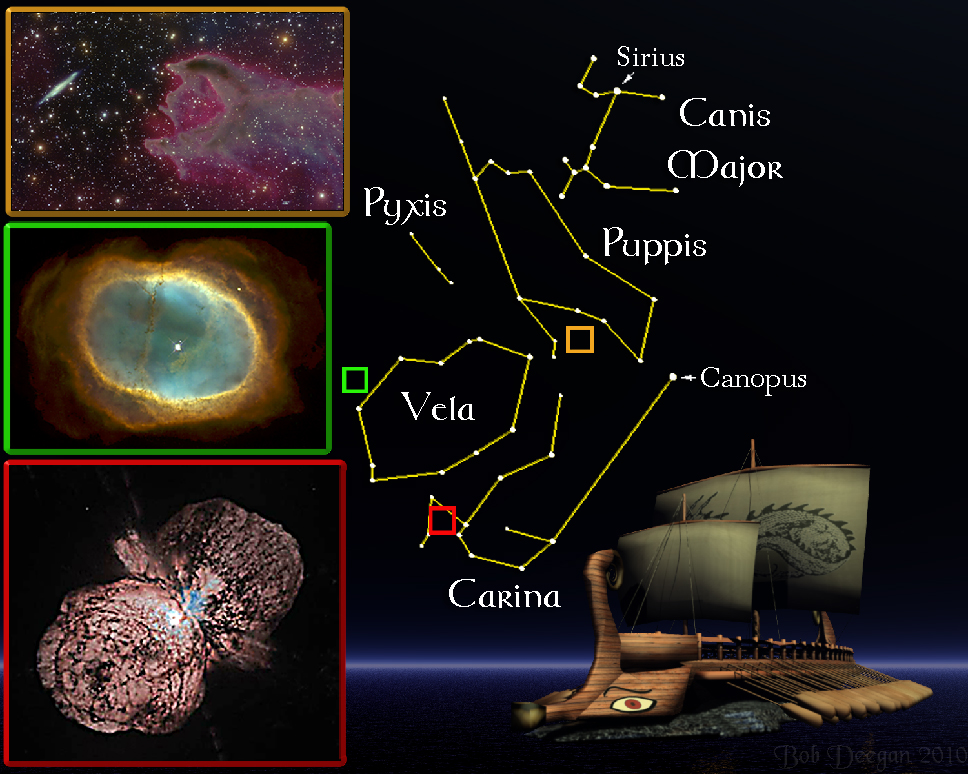
For the week including March 5, 2010

THE ARGO
These evenings the star Sirius shines with a dazzling brilliance in the south. Because it’s the brightest star we see at night, others nearby are often overlooked. It’s a bit of a shame though, just nearby lie the stars of Argo Navis, an ancient constellation filled with romantic legends from Greek mythology. This used to be one of the largest constellations in the sky, but most of it lies beyond our view, hidden beneath the horizon.
Only those people in our country’s southernmost states can see it all, including the gleaming Canopus, which follows Sirius as the brightest star visible at night.
Argo Navis refers to the ship Argo that carried Jason and his all-star crew on their quest for the Golden Fleece. This Golden Fleece was said to have had wondrous and magical powers, but the ram that wore it was not too keen on giving it up. The ram lived at the end of the Earth and was guarded by fierce monsters. Jason and his crew (which by varying accounts included Hercules, Orpheus, and Theseus), guided the Argo past the crashing rocks of Scylla and the whirlpool Charybdis, fought the Hydra, a many-headed dragon, and captured the Golden Fleece. After Jason’s adventure, the gods placed his ship among the stars. The Golden Fleece was elevated too and became the constellation of Aries, the Ram. So detailed were the legends that many historians have offered maps that plot various routes that the Argo traveled. The monsters Scylla and Charybdis were said to live in the Strait of Messina, other philosophers placed them at the entrance to the Bosporus. Even the famous mathematician and scientist, Isaac Newton, became convinced that the legend of Jason and the Golden Fleece was based on a true story. Biographers have explained his strange belief as a product of years of mental illness complicated by the effects of mercury poisoning acquired during his alchemy experiments. In The Chronology of Ancient Kingdoms Amended, published after his death, Newton offered astronomical events sometimes sited in the Argo’s legend to show that the world and its civilizations were not so old as believed and that perhaps only a few thousand years had passed since the biblical creation.
In 1763 the constellation of Argo Navis was broken up into four components, Carina, the Keel, Malus, the Mast, Vela, the Sails, and Puppis, the Stern. Years later, the stars of Malus, the Mast, were fashioned into the constellation of Pyxis Nautica, the Ship’s Compass -- an invention that would have made Jason’s travels a lot easier. Having a bow section might have come in handy too, but apparently they ran out of stars in the region.
In the midst of Argo Navis, our illustration shows some of the favorite targets of amateur astronomers. In the National Optical Astronomy Observatory photograph at upper left is CG4, a fine example of a cometary globule. Although it seems about to devour a galaxy, this is actually a vast expanse of glowing gases and dust blowing off a group of young hot stars. The Hubble Space Telescope photograph at center left shows the glowing gaseous envelopes expanding away from an elderly star that has formed the Eight-Burst Nebula. THe Hubble photo at lower left shows the erupting Eta Carinae. This star is in its death throws and may soon explode in a destructive supernova that will wreak havoc across many light years of space.Unless otherwise indicated, all content of this web site is the copyright of Robert Deegan and all rights are reserved.
For more information, or to comment, please contact: Bob@NightSkies.org